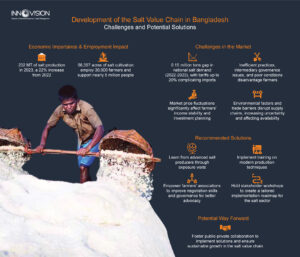
The salt sector in Bangladesh is a vital part of the agricultural economy. According to the Bangladesh Small and Cottage Industries Corporation (BSCIC), Bangladesh achieved a record salt production of 2.232 million tons in 2023, marking a 22% increase from the previous year. This achievement was due to favorable weather, an extended production season, and strong government support. The total salt cultivation area in Bangladesh currently stands at 68,357 acres, with key production zones located in coastal areas such as Cox’s Bazar and Chittagong. Salt can be produced through various methods, including solar evaporation, rock salt mining, and vacuum evaporation. In Bangladesh, the primary method of salt production is solar evaporation. This sector employs around 30,000 salt farmers and supports nearly 5 million people through its value chain, which encompasses both crude salt production and refining processes.
Despite a steady increase in domestic crude salt production over the past years, Bangladesh still struggles to meet the national demand. According to the National Salt Policy this gap was 0.15 million tonnes in 2022-2023. To bridge this gap, the Ministry of Commerce permits qualified importers to bring in unrefined salt for domestic processing when necessary. However, tariffs and trade barriers, which can add up to 20% to the cost of imports, complicate these efforts. Additionally, stringent government regulations and competition from subsidized salt production in countries like India and China hinder Bangladesh’s ability to export its salt internationally. By boosting domestic production to fully meet the country’s crude salt demand, Bangladesh could reduce its reliance on imports and potentially save on costs.

According to a recent study conducted by the International Labour Organization (ILO) on the salt value chain in Cox’s Bazar, the salt industry in Bangladesh faces several significant challenges that impede its growth and sustainability. One major issue is the reliance on inefficient traditional farming practices, which not only results in lower productivity but also leads to poorer quality of farm-stored salt, ultimately affecting the industry’s competitiveness. Additionally, the sector suffers from a lack of innovation, with limited adoption of modern techniques that could enhance yields and reduce costs.
Governance within the value chain is another critical concern. The dominance of intermediaries, such as brokers who control land leasing and pricing, creates unfavorable terms for salt farmers, exacerbating their financial struggles. Furthermore, workers in the industry often endure poor working conditions and a lack of formal employment structures, which is compounded by limited access to financial resources.
Fluctuating market prices add to the uncertainty regarding income for both farmers and workers, making it challenging for them to plan and invest in their operations. Collectively, these factors—ranging from production inefficiencies and inadequate governance to poor employment conditions—hinder the development of the salt sector and negatively impact the livelihoods of those involved.
These pressing challenges in the sector can be mitigated through a series of targeted interventions which can be implemented within a collaborative partnership model between the private and public sectors. This model should involve key stakeholders, including salt farmers’ associations, workers, private sector actors (such as salt millers, traders, buyers, and storage facilities), and BSCIC.
One key intervention can be facilitating exposure visits for key stakeholders to countries with advanced salt production practices. Such visits would allow participants to learn about improved methods and better working conditions, which can be adapted to local contexts. Additionally, providing comprehensive training sessions led by national and international experts is essential. These sessions should focus on modern production techniques that not only enhance productivity but also improve working conditions for farmers and workers.
Strengthening the capacity of farmers’ associations is also crucial for improving their negotiation and collective bargaining skills. This empowerment will enable them to advocate more effectively for their interests and promote better governance within the value chain. Furthermore, enhancing the capacity of various market participants, including farmers, traders, and buyers, on good labor practices, market engagement, and industrial relations will create a more equitable environment. This can help reduce exploitation by intermediaries and improve overall market dynamics.
Finally, conducting workshops with all stakeholders in the salt sector can lead to the development of a detailed implementation roadmap for feasible technologies. These workshops will foster collaboration among actors, ensuring that innovative solutions are tailored to the sector’s specific needs.
To sum up, the salt sector in Bangladesh presents significant potential for growth and development. While the industry has made notable strides, addressing challenges such as inefficient production methods and limited access to resources is crucial for its continued success 24. Implementing recommended strategies, such as enhancing training programs, improving working conditions, and fostering collaboration among stakeholders, can significantly boost productivity and sustainability in the salt sector. This, in turn, would contribute to economic growth, generate employment opportunities, and improve livelihoods for the local population.
Author: Sayera Sun-Um Nusaka, an Associate in the Economic Growth Portfolio at Innovision Consulting